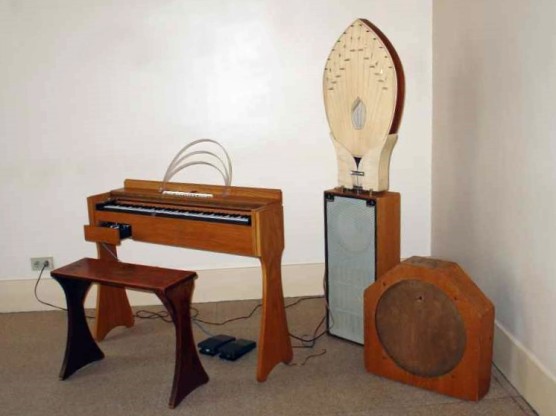Grove Koger
In my December 10, 2018, post about French composer Olivier Messiaen and his Turangalîla-Symphonie, I mentioned the ondes martenot (pronounced OHND mar-tə-NOH) the electronic instrument that the composer made such creative use of. Although it’s been around for nearly a century, the instrument, whose name translates as “musical waves,” is far from common, and few American concert-goers are familiar with it.
The instrument’s inventor was Maurice Martenot (1898-1980), a French radio operator and cellist who was intrigued by the sounds that military radio oscillators produced when their frequencies “overlapped.” He created his instrument with radio tubes generating two supersonic frequencies that in turn produced sounds at a lower frequency (equal to the difference in their rates of vibration) audible to human ears. A loudspeaker or loudspeakers then amplified the resulting sounds. Martenot demonstrated the first version of his invention in May 1928 at the Paris Opera.
In what seems to be its most common version, perfected over subsequent years, the ondes is housed in a simple wooden frame. The player (ondist) slips a ring attached to a continuous ribbon of wire onto her finger and slides her hand back and forth along a nonfunctioning keyboard provided for guidance in selecting pitch. She wobbles her finger very slightly to add vibrato, and she can manipulate controls with her left hand in order to vary the intensity and timbre (character) of the sound. In recent years, enterprising musicians have upgraded the instrument by adding a functioning keyboard that can be wiggled to produce vibrato.
Martenot utilized an amplification system of three different loudspeakers. One was actually a gong that produced metallic sounds, while another (a “palm” speaker) was laced with tuned strings that “chimed” to equivalent pitches.
Estimates of the number of classical compositions featuring the ondes vary from over 100 to over 1000. The most prominent composers using it have been French, and besides Messiaen include André Jolivet and Edgard Varèse (who spent much of his life in the United States). The instrument has also become common in science fiction and horror movies, and pop and rock musicians have turned to it from time to time.
Here’s a link to a YouTube video of Cynthia Miller demonstrating a modern ondes: https://www.youtube.com/watch?v=yidV0HeVyCg&t=11s
Here’s a link to the live YouTube performance of Turangalîla-Symphonie that I recommend: youtube.com/watch?v=8PjyCpRKDrk&t=2271s&index=13&list=WL
Here’s a recording (not live, unfortunately) of Jolivet’s exciting Concerto per Onde Martenot e orchestra: https://www.youtube.com/watch?v=OfhAKLUp_LE&t=243s
And here’s a link to a live YouTube performance of Varèse’s Ecuatorial, which calls for two of the instruments: https://www.youtube.com/watch?v=qM4ALq9-Y1g
□□□
Martenot patented his ondes martenot in 1928, the same year that another gifted inventor, Léon Theremin, patented his own, simpler electronic instrument, the theremin. Varèse actually called for two theremins in an earlier version of Ecuatorial, but switched to the more sophisticated ondes in the version mentioned above. I’ll talk about the theremin another time.
□□□
The image of the ondes at the top of the post was taken by 30rKs56MaE (Japanese Wikipedia user) at the Atelier Jean-Louis Martenot in Neuilly and is reproduced courtesy of Wikimedia Commons under the terms of the GNU Free Documentation License. See details at https://en.wikipedia.org/wiki/GNU_Free_Documentation_License.
